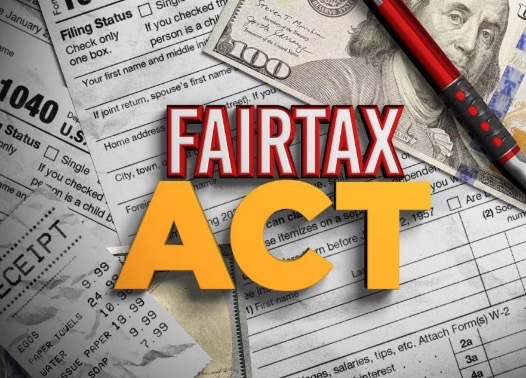A Conversation Sparked: FairTax Act

February 9, 2023
In early January 2023, U.S. Rep. Earl “Buddy” Carter (R-GA) proposed a national sales tax on the use or consumption of taxable property and services. This radical bill would not only work to abolish the IRS, but it would also replace any existing “federal taxes with a flat, nationwide 30% sales tax” (Smith 2023). While this bill does not have much chance of passing, it is a start in sparking a discussion regarding our current tax code.
In terms of the fiscal challenges the U.S. is on track to face over the coming years, a discussion regarding tax reform was guaranteed to surface. With that being said, what is a fair tax rate and what does that mean for our economy?
The bill itself outlines a 23 percent tax rate on both taxable property and services, combined with federal taxes, raising the tax rate closer to 30 percent. This rise in tax rate is set to take place in 2025 under the administration of each state’s treasury. The tax revenues would be distributed over “5 different categories: the old-age and survivors insurance trust fund, the general revenue, the hospital insurance trust fund, the federal supplementary medical insurance trust fund, and the disability insurance trust fund” (Kaufman 2023). Depending on guidelines set for poverty levels and family size, U.S. citizens will receive a monthly tax rebate – a Family Consumption Allowance.
To combat the tax code challenges the US will face in the coming decade, Democrats and Republicans should come to realize that incorporating a flat tax may come as an easier burden than what meets the eye.The least painful option in terms of a smaller burden placed on working families and our economy as a whole. “The center for a Responsible Federal Budget projects that the annual budget deficit could expand as much as 10% of gross domestic product by 2023” (Smith 2023). In that case, interest payment alone would account for half the deficit, assuming the Federal Reserve Board is consistent in keeping interest rates high, combating inflation.
In order to close the gap through spending cuts alone, an across-the-board reduction of 25 percent would be necessary. It is likely, however, that Social Security and defense would not suffer any major reductions, leaving cuts to rise to 50 percent. This 50 percent would then be applied to Medicare, Medicaid and other necessary programs.
The prospect of refining the deficit without increases in revenue is challenging to complete without curbing economic growth. Since World War II, the Obama administration found that “increasing taxes by 1% of GDP would lead to a drop of 2% to 3% in economic output” (Smith 2023). In shrinking the deficit, the $31 trillion debt load the U.S. faces becomes more severe because interest payment will be raised as a percentage of gross domestic product.
It is common knowledge by any economist that flat consumption rates are better for our economy than the system we have in place because this advantage grows as tax rates rise. The FairTax Act proves unrealistic because in enacting the flat consumption tax, the entirety of tax collection is placed on retailers. As tax rates rise, selling goods and services will be a thing of the past.
To combat this issue, many countries have switched to a value-added tax, or VAT. Similar to the sales tax, the VAT targets consumption rather than income. The average VAT rate in the European Union is about 21 percent, and it is calculated based on the tax itself. Considering that the VAT combines both payroll and income taxes on top of itself, while the FairTax act replaces the income and payroll taxes, the FairTax act seems like a deal.
The FairTax act was passed in place of the VAT because the VAT can be associated with high-tax countries in western Europe. This would have caused unforeseen backlash among our constituents. While these two taxes are inherently different, they would both hold the same narrative — to help raise revenue without exacerbating job growth and investment. The difference, however, is that while the VAT was passed to combat higher spending in European countries, the FairTax Act’s supporters are looking to terminate the IRS. Regardless, a flat tax rate on consumption is the most efficient way to raise revenue while preserving economic growth.
Despite which side, Republican or Democratic, a person chooses to stand behind, our tax crisis is a conversation better had now than later. It is no secret that our deficit is here to stay, and spending cuts are imperative to balance the budget. In the acceptance of increasing revenues and demanding an efficient tax, maybe we can get ahead of a crisis before it strikes.






